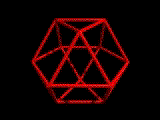On the Concept of HyperToons
by Kirby Urner
December 7, 1996
Last updated: July 24, 2005
A hypertoon is constructed around a catalog of key frames defining all the available start and stop points for any animated segment in the hypertoon. Each animation or 'scenario' could be a morphing sequence or any other transformation or action. By creating a network of scenarios interlinking key frames, we get (a) smooth segues from one scenario to another and (b) the ability to randomize or choose pathways through the hypertoon, as each key frame becomes a 'switch point' leading off in multiple directions to other key frames.
For example, key frames in a Synergetics might be:
- Tetrahedron
- 12-spheres-packed around one
- Cuboctahedron
- Cube
- Rhombic Dodecahedron
- Tetrahedron[k] turns inside-out in multiple directions creating Cuboctahedron[k]
- 12-spheres-around-1[k] morph into rhombic dodecahedra then all converge to a central Rhombic Dodecahedron[k]
- A cube[k] develops body diagonals creating half-octahedra which bulge outward through each face to give a Rhombic Dodecahedron[k]
- A Tetrahedron[k] gives rise to its dual and these in turn give rise to a stabilized Cube[k] (duo-tet) from which the tetrahedra have disappeared
- 12-spheres-around-1[k] fade to reveal the cuboctahedron[k] which defines their relative placement
[k] = key frame
 |
We see that each of the scenarios can be run in either direction (one of the fun attributes of geometry cartoons), but each may nevertheless be defined with a directional attribute, to force the computer to enter it from only one end. The goal is to design a looping network of connected 'edges' (lines) where each edge is a scenario, and the vertices are the key frames. A well designed network will not have any deadends and will allow for a wide variety of pathways. Set to run 'ad infinitum' with a randomizing algorithm at each node, the effect would be a continuous hypertoon, wherein scenarios would repeat, but not predictably nor simply.
![]() Although the typical
hypertoon segment links any two key frames in a network, we may
also have segments that begin and end with the same frame, closed
loops anchored to a single node. For example, if we wished to show
that a baseball's stitching pattern, seen from the proper angle,
looks like the oriental yin-yang symbol, we could start with the
baseball [k] and fade to the yin-yang and back to the
baseball [k]. Then we could take any of several other routes
from the baseball to other key frames in our hypertoon network.
Although the typical
hypertoon segment links any two key frames in a network, we may
also have segments that begin and end with the same frame, closed
loops anchored to a single node. For example, if we wished to show
that a baseball's stitching pattern, seen from the proper angle,
looks like the oriental yin-yang symbol, we could start with the
baseball [k] and fade to the yin-yang and back to the
baseball [k]. Then we could take any of several other routes
from the baseball to other key frames in our hypertoon network.
The scenarios may or may not come with sound tracks. In cases where they're defined as reversible, the music or sound effects would have to be triggered to play in a sensible direction regardless (e.g. scenario with explosion in the middle could have that sound triggered from either direction, but the wave form itself would likely always be played in the same direction -- unless maybe we're playing 'embedded messages' games).
HyperToons may be implemented on a variety of platforms of course. Optimized designs will not stall or pause as scenario choices are made, but will slip through the key frames smoothly. In practice, some hypertoon engines will randomize ahead of time, generating 'scripts' of whatever specified length. Such a script could drive a video editing machine to record the scenarios in sequence, such that the smooth looping quality would be available at playback. With powerful computers, the opportunity exists to do more realtime switching, although some buffering or queuing ahead of the displayed action will still likely be necessary to avoid pauses at the key frames.
Not all hypertoon implementations need employ randomizers which leave nothing to viewer discretion. Interactive hypertoons make the nodes actual decision points, with interface tools giving browsers the means to navigate through the network at will. Many hypertoon implementations will provide both modes of operation (automatic and user-controlled).
The interface tools for creating hypertoons is a whole other topic. Given the metaphor of key frame nodes and scenario edges, many interfaces will want to provide graphical ways of wiring up new scenarios to growing networks. Given that scenarios may be of different length, and may have other distinguishing properties, the opportunity exists to create complex networks with dynamical properties at run time. For example, in a videogame style hypertoon, some scenarios will be closed or concealed from the user until various conditions are met (the 'secret tunnel' pattern).
 |
I am not trying to copyprotect the concept of hypertoon because I do not wish to hamper its implementation. I've been discussing hypertoons and their implementation within my network for well over a year by this time. The concept is very generic and needs to stay in the public domain. However, lots of proprietary implementations will derive from these concepts. Commerical products with trade value will no doubt grow up around the hypertoon idea.
Personally, I am looking forward to synergetics-informed hypertoons making a debut on shows like Sesame Street one day soon (remember, although conceptually runnable 'ad infinitum' any given hypertoon will have a start and stop time in our scenario Universe). I'm also looking forward to seeing hypertoons placed discreetly in public places (e.g. airports) to provide some entertaining ambient video (commercial free, though with the display device itself crediting a commerical entity, e.g. SGI).
Hypertoons via the internet might take the form of a runtime player for queuing up segments from a library of downloadable segments, based around a given (perhaps growing) set of keyframes. The player might incorporate an existing standard (AVI, MOV, MPEG), while adding a layer of software to recognize key frames and select from the available scenarios, ideally without any detectable pauses in the action when running in automatic mode. This strategy would allow local looping through the network at runtime without any redundancy in the download itself. Nevertheless, a hypertoon consisting of 100 animated segments, each averaging about 3 seconds in duration, would still add up to a lot of megabytes. One might typically add to one's scenario library gradually over time, starting with the purchase of a runtime library on CDROM. Successive enhancements to the player would also be made available via the internet, along with new authoring tools.
A CDROM might scatter its library of animations across a broad spectrum of topical exhibits, surrounding them with explanatory text and graphics, thereby hiding their mutual interconnectedness within a single hypertoon. A synergetics student, for example, would first apprehend each scenario in its curriculum context, coming to appreciate the concepts involved, their links to chemistry and culture, and then select the option to run all the scenarios in the library through a hypertoon player. The hypertoon overview mode might produce a kind of epiphany, given the volume of information summarized within it. "I saw my whole life, flashing before my eyes..."
Note: special thanks for Richard Hawkins for inspiring me to brainstorm about hypertoons when trying to win a 1995 contest for the best use of an SGI computer (and of course for his marvelous graphics, including the three above).
Followup: I finally coded a working Hypertoon in 2005, using Python + VPython. I've got a write-up here.
Of course the web itself is a kind of 'hypertoon' though here the experience of moving from node to node is not an animation (unless you count the browser's logo). One might think of web pages as stops along the rails, the edges between them as rails. Come to think of it...
Synergetics on the
Web
maintained by Kirby Urner